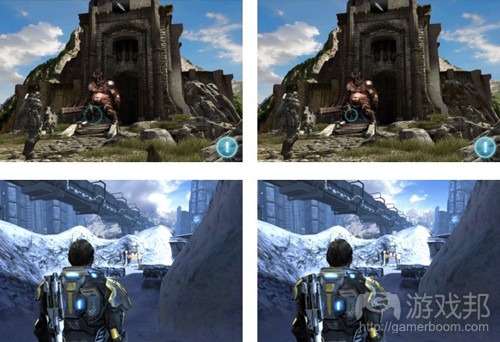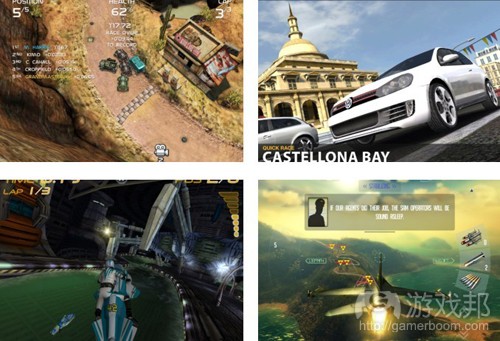解析苹果新iPad以及iOS游戏的变革趋势
作者:Richard Leadbetter
在过去的数年时间里,移动设备处理器和图像性能有了很大的提升,几乎没有公司能够像苹果这样展示出这种硬件设备的卓越游戏能力。此前,iPad 2的发布让我们看到了GPU性能提升了5倍,但这是几个月前的事情了。
明年,行业将会发生很大的改变:新的框架面世,我们很可能最终会看到移动设备性能超越当代HD主机,苹果自然成为此次变革的领头羊。但是,近期苹果新iPad的发布被形容为当代ARM和PowerVR硬件的最后一次飞跃,今年众人的关注点显然是新的Retina显示技术。
从整体规格来看,最新的iOS平板电脑看起来与现有的iPad 2很相似,但后者将降价继续出售。两者的整体设计美学几乎相同,唯一的显著差别在于新平板电脑显然更重且厚度有所增加。当新的A5X处理器运行富有挑战性的3D内容时,你会注意到该平板电脑更容易发热。如果你将iPad装在保护套中使用,就更能明显地感觉到这点。
存在这些瑕疵都是因为整合了由三星供应的新Retina屏幕,它使iPad的分辨率从原本的1024X768提升至2048X1536。新屏幕和A5X处理器更为耗电,苹果采取了昂贵的解决方案来应对电池寿命问题:将iPad 2中使用的25瓦时电池升级成42.5瓦时的锂离子电池。
(相对比iPad 2,GPU性能提升了两倍,但并不能够完全利用新Retina将显示分辨率提升4倍。在以上《无尽之剑2》和《质量效应:渗透者》运行情况的比较中,我们可以看到新硬件运行游戏的分辨率在1440X1080左右。)
A5X处理器在新硬件中的使用同样令人感到意外:许多人猜想苹果会在新设备中同提升CPU和GPU,但目前获得升级的只有图像技术,与iPad 2相比有了两倍的提升,承载的却是实现分辨率提升4倍的任务。这样的搭配使新设备出现些许不足之处:对《质量效应:渗透者》和《无尽之剑2》等图像密集类游戏而言,Retina的升级并不能使屏幕真正呈现2048X1536的分辨率,但与iPad 2版本相比,在细节方面依然能够实现将近两倍的优化。
《欲火银河2 HD》、《现代战争3》和《空中制霸:制空权》等游戏尽管支持全Retina分辨率,但是帧率与在老设备上运行相比有所降低。《激流快艇:Riptide GP》采用了有趣的方式,游戏中含有图像菜单选项,允许玩家根据自己的偏好来调高分辨率,同时告知玩家这会影响游戏的帧率。
对于A5X的技术组件,或许人们最大的惊讶在于其大小:使用163mm2的硅材料,采用45nm的工艺(游戏邦注:同样由三星提供)。对于移动设备而言,这样的处理器过大,其所占的空间是NVIDIA产品Tegra 3 SoC的两倍。事实上,该芯片的大小接近于英特尔2010年产品酷睿双核Q9500桌面电脑处理器的大小,后者采用的也是45nm工艺。包括我自己在内的的许多科技媒体评论者都认为苹果会采用32nm或28nm工艺,但是苹果却选择了更大的处理器,用更高容量电池与之相配。
一方面,我们很难不产生以下想法:苹果倾尽全力来打造新平板电脑,以实现屏幕分辨率的提升,从而导致生产成本更加昂贵。但是另一方面,我们也很难认为其他有着同样愿景和充足资金的制造商也会选择这么做。显然我们便会得出结论:苹果并不会将自己的成功视为理所当然的事情,也没有因在移动市场的统治地位而自鸣得意。即便是第3代的平板电脑,该公司仍然在不断推行创新做法,在竞争领域设定标准。
新iPad的发布还为那些关注设备售价的消费者带来福音。那些并不追求新Retina屏幕的人现在可以花330英镑购买iPad 2,如果有幸赶上eBuyer等在线零售商的特别促销活动,花300英镑左右就足够了。iPad 2在功能上几乎同新iPad相同(游戏邦注:除了摄像头和几乎无用的键盘语音识别插件),所以在熙攘的平板电脑市场上依然位居前列,只会被它的接班者和华硕Transformer Prime等某些专门化产品所击败。在我的家人看来,新iPad和iPad 2是毫无差别的,现在对新屏幕的称赞渐渐变少,家人对这两款设备都很喜欢,或许众人认为苹果现在拥有了两个售价不同的卓越产品。老产品售价的下跌还影响到Android平板电脑的竞争力,近期发布的华为Media Pad售价300英镑,现在看来无疑是定价过高。
(《死亡赛车》和《真实赛车2 HD》在新iPad上保持了与其iPad 2版本相同的表现,同时利用了全Retina分辨率,但《空中制霸:制空权》和《激流快艇:Riptide GP》无法流畅运行。然而,《激流快艇:Riptide GP》提供了下调分辨率的选项,这样游戏便能够更加流畅,这是种有趣的折中方法。)
那么,接下来苹果和移动技术将如何发展呢?根据传统做法,新iPad技术将终结于下一代iPhone,目前iPhone 4S采用与iPad 2相同的A5处理器,运行速度下调20%以延长电池使用时间。但是,A5X似乎是专门针对新iPad的屏幕进行设计的,很难想象iPhone会在屏幕分辨率已经达到Retina级别的情况下还需要双核GPU。Anandtech提出了个有趣的想法,认为现有的A5将会被缩减成28nm或32nm工艺,以便提升电池寿命,同时添加4G支持,这会使新iPhone成为另一个衍生产品,而不是开辟性的新产品。
Anand还认为,下一代处理器A6带有双核Cortex A15,并结合了来自IMG的PowerVR Rogue框架,或许将用于明年的平板电脑,也就是所谓的“iPad 3”。
但是,压缩版的A5处理器结合4G支持,这无疑会让下一代的iPhone显得毫无新意和竞争力。索尼同样将在年末面世的NovaThor芯片集中结合下一代ARM/IMG技术,所以苹果可能会选择新iPhone作为呈现A6性能的设备。Anand认为这样的时间安排过于紧迫,但是如果新iPad表现不出众,那么苹果会考虑加快步伐。
A15和Rogue的组合确实是件大事。我们已经见过AAA内容能够在移动平台上运行,比如《失落的星球2》在Tegra 3上运行,但是就GPU马力而言,Rogue应当能够实现甚至超越Xbox 360中Xenos图像芯片的性能。事实上,新IMG芯片应当带有额外的DirectX 11图像功能和资源,这就相当于告诉我们,它能够超越目前iPad 3和PlayStation Vita的SGX543硬件表现。从理论上来讲,下一代的iOS设备(包括传闻中的苹果TV)有望成为AAA跨平台游戏开发目标。
如果马力符合条件的话,那么AAA游戏实现跨平台的障碍就是存储和输入设备的问题。就控制器而言,目前已有传言称苹果正在研发适合传统游戏的插件,我觉得如果iOS游戏平台想以电视机的形式进入用户客厅的话,这是必要之举。
增加存储容量确实对处理更复杂游戏很有用,但就当前iOS平台的容量增长速度来看,这方面还需要加快。随着iPad屏幕过渡到Retina技术,我们已经看到游戏文件大小迅速增加,2D美术和更高清纹理使一些游戏的下载文件大小增加到原本的两倍,这对那些拥有更高容量的第3代iPad用户来说确实是个好消息,但是给其他用户带来一定的麻烦。
对于最新的iPad,16GB的最小容量似乎已经显得有些不足,我希望下一代iPad最小容量能够提升至32GB。现在,较有名气的16GB USB flash驱动成本不足7.5英镑,而且从苹果愿意花大成本提升电池容量和设定显示标准来看,上述情况的出现只是时间早晚的问题。
但是毫无疑问,苹果对公司旗下游戏帝国的扩张已经有了清晰的蓝图,在合适的时间用合适的产品占领移动市场,用市场上最强大的图像硬件提供支持。苹果的市值已超过6000亿美元,目前的问题并非苹果是否会将其游戏品牌扩张到用户家中,而是它将在何时通过何种方法扩张。(本文为游戏邦/gamerboom.com编译,拒绝任何不保留版权的转载,如需转载请联系:游戏邦)
Tech Focus: The New iPad and the Evolution of iOS Gaming
Richard Leadbetter
Mobile processing and graphics power has increased by orders of magnitude over the last few years and few companies have done more than Apple to showcase the gaming capabilities of this exciting, powerful, energy-efficient hardware. Remarkably, we’re now months away from a generational leap in mobile performance even more radical than the 5x jump in GPU performance we saw with the arrival of the iPad 2.
Next year, everything changes: new architectures roll out and there’s a strong possibility we will finally see mobile parts theoretically surpass the performance of the current generation of HD consoles – and Apple will almost certainly be at forefront of this revolution. However, the recent release of Apple’s “New iPad” is best described as the last great hurrah for the current generation of ARM and PowerVR hardware – this year the focus is clearly on the new Retina display.
In terms of overall form factor, the latest iOS tablet looks remarkably similar to the existing iPad 2, which continues to be sold alongside the new one at a $100/£70 discount. The overall design aesthetic is effectively identical with the only noticeable changes being that the new tablet is noticeably heavier and slightly “fatter”. When the new A5X processor is put through its paces with challenging 3D content, you’ll also notice that the tablet can get rather warm too, something that can become much more pronounced if you have the iPad inside a case.
All of these compromises are present in order to accommodate the new Retina screen supplied by Samsung, which quadruples resolution from the iPad’s traditional 1024×768 up to an extraordinary 2048×1536. The screen almost certainly sucks up a lot more juice and the A5X processor also adds a significant hit to battery life. Apple’s somewhat expensive solution is to seriously beef up the battery power provision – the 25 watt-hour batteries of iPad 2 give way to 42.5 watt-hour lithium-ion cells in the new tablet.
(A 2x GPU upgrade over iPad 2 can’t always serve 4x the resolution represented by the new Retina display. In these comparison shots of Infinity Blade 2 and Mass Effect: Infiltrator running on iPad 2 and ‘New iPad’, we see the new hardware running the games at around 1440×1080.)
The physical make-up of the A5X processor in itself is also rather surprising: many suspected that Apple would double up on both CPU and GPU cores for its new device, but in the event only the graphics technology has been upgraded, with a 2x boost in power over the iPad 2, being tasked with maintaining 4x the resolution. This results in some compromises: Retina upgrades to graphics-intensive titles like Mass Effect: Infiltrator and Infinity Blade 2 don’t actually address the full 2048×1536 potential of the screen, running at sub-native resolution – but still offering something approaching a 2x boost in detail compared to the iPad 2 versions.
Other titles like Galaxy on Fire 2 HD, Modern Combat 3 and Sky Gamblers: Air Supremacy support full Retina res, but also appear to possess a more inconsistent frame-rate compared to the same games running on the older tablet. An interesting compromise is Vector Unit’s Riptide GP which has a graphics menu option allowing players to scale up resolution to their liking while acknowledging that doing so impacts frame-rate.
Perhaps the biggest surprise about the technical make-up of A5X is just how big it is, occupying 163mm2 of silicon, fabricated on a 45nm process (again by Samsung). This is seriously large for a mobile device – over double the area of NVIDIA’s Tegra 3 SoC. In actual fact, the size of the chip is almost a match for Intel’s 2010 vintage quad core Q9500 desktop processor – produced at a similar 45nm process. Most commentators in the tech press – myself included – believed that Apple would drop down a 32nm or 28nm process, but in the event the firm decided simply to go bigger and fit higher capacity batteries: a choice which must be costing Apple a fortune, especially bearing in mind that the base price of the iPad hasn’t increased over the launch price of its predecessor.
On the one hand, it’s hard to avoid the idea that has Apple has been forced to throw everything including the kitchen sink at the new tablet in order to make that beautiful screen work resulting in a much more expensive BOM (bill of materials) but on the other hand, it’s difficult to imagine any other manufacturer with the audacity, vision – and the deep pockets – required to do the same. The obvious conclusion is that Apple is not taking its success for granted, and it isn’t growing complacent in its complete domination of the mobile market. Even with its third generation tablet, it’s continuing to push the boat out, setting the standards that its competition aspires to.
The release of the new iPad also means that there’s good news for value-conscious consumers too. Those who aren’t bowled over by the retina screen can now buy the iPad 2 for £330 – or even around the £300 mark if you manage to catch a special promotion from the likes of online retailer eBuyer. Functionally identical to the new iPad in almost every way (aside from the camera and a fairly useless voice recognition add-on for the keyboard), iPad 2 remains near the top of the pile in the crowded tablet marketplace, only beaten by its own replacement and more niche, specialist products like the Asus Transformer Prime. New iPad and iPad 2 have proven to be virtually interchangeable in my own household (the new screen gets a few “ooohs” every now and again but the family are happy to use either device) perhaps suggesting that Apple now has a brace of superb products at two price-points. The price reduction on the older tablet also serves to make worthy Android competitors including the recently released £300 Huawei Media Pad now look distinctly overpriced.
A dual tablet product line-up may yet be bolstered by the arrival of a third, budget-orientated product. Intriguingly, developer builds of the latest iOS reveal the apparent existence of another iPad 2 running the same revised single-core A5 chip we see in the new 1080p-capable Apple TV. Bearing in mind that the firm’s set-top box is sold for just $99, a 7-inch Kindle Fire competitor at $199-$250 is an interesting option for the manufacturer.
Update: Recent reports from Anandtech reveal that the new CPU is a 32nm die-shrink of the original A5, with a single core disabled on the Apple TV – the “new” tablet being a revision of the current iPad 2, potentially with improved battery life.
(Death Rally and Real Racing 2 HD (top) on the new iPad manage to maintain performance equal to their iPad 2 renditions while running full Retina resolution, while Sky Gamblers: Air Supremacy and Riptide GP (bottom) fail to run as smoothly. However, Riptide GP offers the ability to downscale resolution in order to enjoy more consistent frame-rates – an interesting compromise.)
So, where next for Apple and the mobile technology it has spurred on with its yearly revisions? Traditionally, new iPad tech has always ended up in the next iPhone – the current 4S features the same A5 processor as iPad 2, running 20 per cent slower to conserve power. However, A5X seems to be designed especially with the new iPad’s screen in mind, and it’s hard to imagine why an iPhone would require a quad core GPU when display resolution is already at the Retina level, and coping very nicely indeed with the A5′s existing SGX543 MP2. Anandtech posits the interesting theory that the existing A5 will be die-shrunk to 28nm/32nm for improved battery life and gain 4G support: which would make the new iPhone another revision as opposed to a groundbreaking new product.
Anand also suggests that the next-gen processor – A6 – features a dual core Cortex A15 in combination with the PowerVR Rogue architecture from IMG, and it set to debut in next year’s tablet, something I mentioned in a recent analysis of the remarkable rumour-mongering surrounding what was then referred to as the iPad 3.
However, a die-shrunk A5 with 4G modem surely leaves the next iPhone potentially looking rather anaemic. Bearing in mind that Sony is looking at exactly the same combo of next-gen ARM/IMG tech for its upcoming NovaThor chipset due at the end of the year, perhaps Apple will choose to debut A6 in the new iPhone instead. Anand believes the timing is too aggressive for that, but if the new iPad demonstrates anything, it’s that if Apple wants something to happen badly enough, nothing can get in its way.
An A15/Rogue combo is a seriously big deal. We’ve seen hints and demos of AAA content running on mobile platforms before – Lost Planet 2 running on Tegra 3 for example – but certainly in terms of GPU horsepower, Rogue should be able to match and exceed performance from the Xenos graphics core found in the Xbox 360 – indeed, the new IMG chip should also feature additional DirectX 11 graphics features and sources tell us that it blitzes performance of the SGX543 hardware in the current iPad 3 and PlayStation Vita. In theory, next-gen iOS devices – including the much-rumoured Apple TV for the living room – could potentially become a target for AAA cross-platform game development.
If the horsepower is there, the concept of AAA crossover then becomes a matter of storage and input devices. In terms of controllers, rumours are already circulating that Apple is investigating an add-on for more traditional gaming: something I would see as essential if the iOS gaming platform is to migrate into the living room in the form of a full TV set, but would be a nice addition for the other devices too with Bluetooth being the logical interface there.
Increasing storage would be very useful indeed for handling more complex games, but even with the current gradual evolution of the iOS platforms, available space clearly needs to increase. With the transition to Retina technology on iPad, we are already seeing file sizes for games expand rapidly – 2D art and higher resolution textures have seen anything up to a 2x rise in download sizes in some cases: great for those with higher capacity third gen iPads, but bloat for everyone else.
With the latest iPad, a 16GB entry level is suddenly looking very restrictive and I’d hope that this would rise to 32GB in the transition to next-gen. In a world where branded 16GB USB flash drives now cost less than £7.50 and where Apple is content to spend so much money on high capacity batteries, standards-setting displays and enormous (in mobile terms) processor packages, hopefully this is only a matter of time.
But make no mistake, Apple has clear designs on expanding its gaming empire, having dominated the mobile sector with the right products at the right time, backed by the most powerful graphics hardware in the market. In a week where Apple’s market cap has exceed $600bn and where it accounts for 36 percent of S&P’s total 500 Index Q1 earnings, the sky’s the limit. It’s no longer a case of whether Apple will bring its own brand of gaming to the home, it’s a matter of when and how… (Source: Games Industry)









































 闽公网安备35020302001549号
闽公网安备35020302001549号